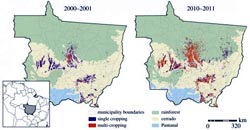
Rice, grown as a staple food for a large portion of the world’s population, absorbs arsenic from the environment and transfers it to the grain. Arsenic is…

An international team of scientists aims to lessen the reliance on these fertilizers by helping beans and similar plants boost their nitrogen production, even…

In an effort to reduce their costs, pork producers are looking for alternative sources of calcium (Ca) and phosphorus (P). Researchers at the University of…

New research finds that double cropping — planting two crops in a field in the same year — is associated with positive signs of economic development for rural…

Researchers with the University of Illinois Crop Physiology Laboratory have been re-evaluating nutrient uptake and partitioning in modern corn hybrids.”Current…

The study, published in the current edition of the journal Science, examines how Ug99 – new virulent forms of stem rust first found in Uganda in 1999—could…